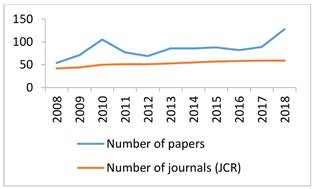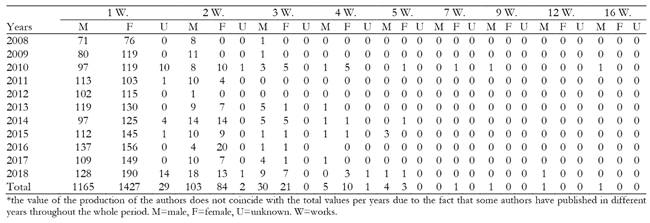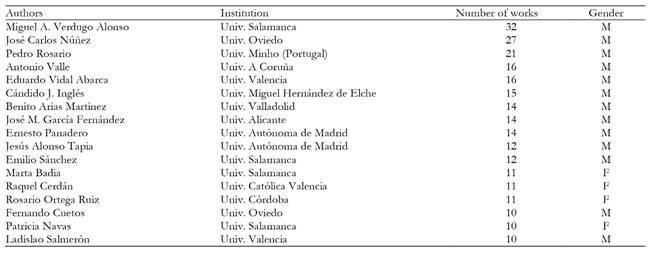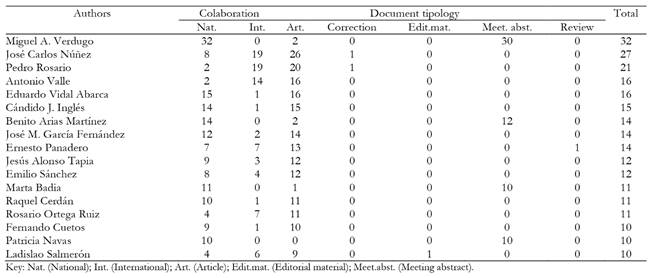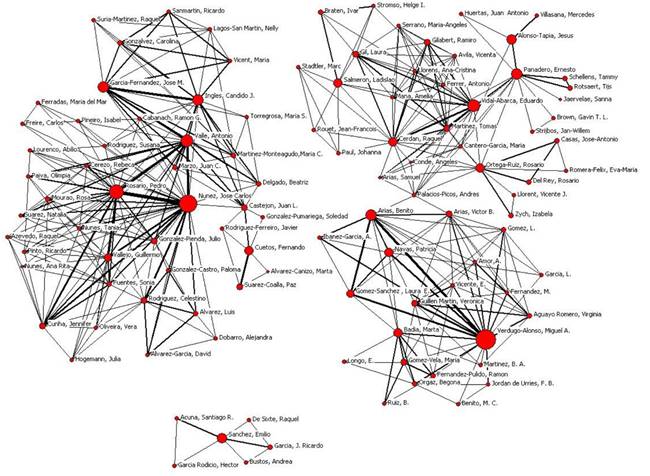Introduction
The analysis of scientific activity based on gender is giving rise to numerous comparative studies that aim to determine whether or not there are differences in the characteristics of scientific activity that researchers of both sexes are carrying out. For this, bibliometric analyses are proving very useful, by allowing to analyse the characteristics of the research activity in an objective way, to see how it is evolving or whether or not there are differences in this activity depending on gender and age, and to compare the results with those of other knowledge areas or geographic regions.
The presence and evolution of women in different fields and disciplines has been the subject of different studies aimed at determining the possible existence of differences in the scientific activity carried out by men and women (Efrain et al., 2014; Haba-Osca et al., 2019; Mayer, Lenherr et al., 2017; Pyatigorskaya & Di Marco, 2017; Ramakrishnan et al., 2014; Torres-Salinas et al., 2010). Studies that have analysed gender differences in collaborative research and the scientific results of interdisciplinarity have also been carried out. The results have indicated that when papers are written exclusively by women, work teams tend to be smaller than any of those that also include men (Araujo & Fontainha, 2017). Other studies have analysed the mobility of researchers based on gender and, in this case, the results indicate that although women present greater international mobility compared to men, however, compared to men, the frequency of international visits of women is less, their visit occur at the beginning of the stages in their career, they are shorter and their destinations are closer to home (Cañibano et al., 2016), being women without children who are participating more actively in mobility programs (De Filippo et al., 2009). Other studies have been devoted to analysing the presence of women in the governing bodies of journals (Addis & Villa, 2003; González-Sala & Osca-Lluch, 2018; Mauleón et al., 2013; Miqueo et al., 2011; Ortega Toro et al., 2015; Stegmaier et al., 2011).
However, despite the fact that the presence of women has increased in all disciplines, some generalist studies on teh status of women in science indicate that researchers publish fewer scientific articles and sign in less relevant positions than researchers, participate in fewer international collaborations and their works receive fewer citations (FECYT, 2017; Larivière et al., 2013; Skinner & Louw, 2009). For this reason, there is currently a growing interest in Spain to improve the situation of women in different professional fields, including scientists and academics (Torres-Salinas et al., 2010). Making women visible by publicizing their contributions in the development of science and the advancement of knowledge continues to be an essential activity in the slow path towards effective equality between men and women. The objective of this work is to know whether or not there are differences in productivity in the research carried out in Spain in the area of educational psychology depending on the gender of the researchers.
Methodology
Material and method
It is important to bear in mind that the results provided by this study are obtained based on the analysis of the records of works published in journals that have been included in the Journal Citation Reports (JCR) databases of the editions corresponding to the years 2008 to 2018. The information collection process was carried out in the Web of Science database, using as a search profile all the titles of the journals included in the thematic category Psychology Educational between 2008 and 2018, both inclusive, entering each one of the titles in the “Source” field. Subsequently, all the studies carried out with the participation of Spanish institutions were selected, using the term “Spain” in the “Address” field and limiting the search to documents published between 2008 and 2018.
The records found were dumped into a database created in Access. All the records obtained were reviewed and the information contained in the author field was normalized, identifying the variants with which the authors' names and sex are registered. Regarding the counting system, the total counting system has been chosen, according to which the recovered documents are assigned to each of the authors participating in the publication. In order to better identify and visualize the relationship between the large producers in Educational Psychology and the co-authors, network analysis software has been used (Borgatti, 2002; Borgatti et al., 2013), creating a table in which the large producers with the co-authors are related, converting into a weighted symmetric matrix.
Analysis
Frequency counting, percentage calculations and χ2 tests were performed to determine the existence of statistical differences between men and women based on the number of works and signatures per year. The analysis of social networks was carried out with the UCINET version 6 program (Borgatti et al., 2014) and the representation of the network graph with the Netdraw software (Borgatti, 2002; Borgatti et al., 2013).
Results
During the period 2008-2018, both years inclusive, a total of 935 papers were published in the journals included in the Psychology Educational category of the Journal Citation Reports (JCR) that included the participation of a Spanish institution. During all the years studied, the number of journals included in the Psychology Educational thematic area has been increasing, going from the 42 journals indexed in the JCR in 2008 to 59 in 2018, which represents a growth rate of 40.76% during the period studies. The number of papers published with the collaboration of a Spanish institution has also been increasing over time, although we can observe, as shown in Figure 1, that there have been large fluctuations and it has varied from a maximum of 128 papers in 2018 to a minimum of 54 in 2008. The growth rate of number of works in 2018 compared to 2008 is 137.04%.
The 935 papers published had a total of 3,304 signatures corresponding to a total of 1,949 authors, of which 1,100 (56.44%) were women, 817 (41.92%) were men and in 32 (1.64%) authors it was not possible to identify the gender.
In the chronological distribution presented in Table 1, a constant increase in the number and percentage of women is observed, going from 48.72% in 2008 to 55.30% in 2018, with 2017 being the one that stands out by reaching its highest level (55.87%). The years 2008 and 2011 stand out for being the years in which the number of male authors exceeds the number of women in the publication of works in Educational Psychology journals included in the WoS. These data reflect the increase in women in Educational Psychology research and coincide with the results obtained in previous studies that indicated that in Educational Psychology the number of women during the periods 2004-2008 and 2009-2013 exceeded that of men (Osca-Lluch & González-Sala, 2017). Although there is an increase in the number of women per years as authors and in the number of signatures, these differences did not turn out to be statistically significant χ2 = 12.186, 10 gl., p = .273, Ф =.065 and χ2 = 16.702, 10 gl., p = .081, Ф =.072, respectively.
Table 1: Distribution of men and women in relation to the years of publication of the works (number of authors and number of signatures).
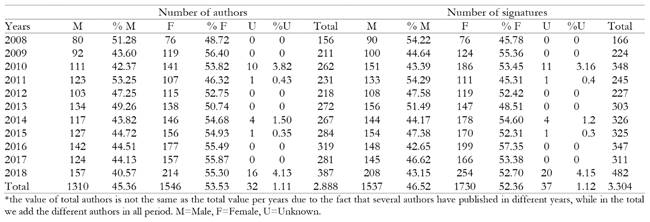
The distribution of men and women in relation to productivity levels (Table 2) shows that throughout the entire period studied, a large proportion of authors (70.55%) are transitory, since they have published a single work during the entire period. period. Among the eventual authors there are more women (72.55%) than men (67.07%). It is also observed that, among the large producers, considering as such those who have published 8 or more works throughout the period, the number of men exceeds that of women, however, among the medium producers (authors between 2 and 7 works), there are a greater number of women than men.
In a given discipline, there is a small group of authors who contribute most of the production while a large number of authors contribute a small amount of work. Lotka (1926) called it a “productivity index”: a system for classifying authors based on the number of works they had published. It distinguishes three levels: small producers (those who have published only one work); medium producers (have published between two and nine works) and large producers (who publish ten or more works). Table 3 shows the classification of authors who have published works in Educational Psychology journals according to their level of productivity. It is observed that, during the period analyzed, 70.55% of the production in educational psychology has been carried out by small producers, that is, authors who have published a single work throughout the entire period analyzed and that only 0.87% of the authors are large producers, that is, authors who have published 10 or more papers. Among the 17 large producers, there are 13 men and 4 women.
When the evolution of the authors' productivity is analyzed throughout the analyzed period, it is observed that the most common number of works published by an author during a year is usually 1 or 2 works (see Table 4). However, during the period analyzed, there are some authors who have published more than 5 papers in the same year. In these cases, the contribution of an author who has published 16 works in 2010 and 12 in 2018 stands out. The production of a second author who has also published 9 works in 2010 and a third author also stands out. which in this case, has published 7 works in the year 2010. However, when the documentary typology of all these works is analyzed, it is observed that, except for one article published in the journal Educational Psychology in 2018, the rest of the works are all Meeting Abstracts that have been published in the Journal of Applied Research in Intellectual Disabilities.
Table 5 shows the list of authors who have published a greater number of works in indexed journals in the JCR Psychological Educational thematic category during the 2008-2018 period and their workplace.
As seen in Table 5, between those 17 authors that have published ten or more works during the analyzed period, there are only 4 women. One aspect that should be highlighted is that 9 of these authors already stood out for their high scientific production in this same discipline during the period 2004-2013 (González-Sala & Osca-Lluch, 2016).
In order to know the characterization of the research carried out by these great authors, the documentary typology of the works carried out by each of these authors and the authorship of the different works have been analyzed. One aspect to be highlighted is that none of these authors has published solo works, all the works analyzed during this period have been carried out in collaboration. As it can be seen in Table 6, the largest number of works have been carried out in national collaboration and the most frequent documentary typology is articles, although some large producers stand out for the large number of works published as Meeting Abstracts.
Scientific collaboration, understood as joint participation with other researchers in research activities, is an essential feature in science, being common in many disciplines that practically all the works are multi-authored by an increasingly high number of authors (Wagner-Döbler, 2001). Scientific collaboration has become an essential practice to be able to complement shortcomings and the organizations responsible for scientific policies try to promote it, demanding or rewarding it in the projects to be financed and adopting measures and programs to promote it (González-Alcaide et al., 2008; Gómez-Ferri & González-Alcaide, 2018). An indicator of the activity of scientific collaboration is co-authorship. The co-authorship analysis reflects a possible role for exchanges between researchers and constitutes a significant procedure, measured by the number of collaborative publications, between authors, institutions or countries and it is used to identify and map regional, national or international cooperation. Therefore, the analysis of co-authorship makes it possible to describe and incorporate the structure of a group that can be represented by a social network.
Figure 2 shows the collaboration network of the great authors in Educational Psychology during the period 2008-2018 together with their collaborators. The total number of authors that are part of the collaboration network of the great authors is 286, however, in the network only the great producers and the collaborators with whom they have signed two or more works have been represented (105 authors), in order to better visualize the existing relationships between the different authors.
The analysis of the co-authorship of scientific publications has made it possible to identify three research groups in Educational Psychology. The largest of the groups is made up of 55 authors. In this group there are two subgroups connected through Andrés Palacios Picos (Univ. Valladolid). The largest subgroup is made up of 32 authors, including a series of authors from different universities with a great production such as Eduardo Vidal Abarca (Univ. Valencia), Ernesto Panadero (Univ. Autónoma Madrid), Jesús Alonso Tapia (Univ. Autónoma Madrid), Raquel Cerdán (Univ. Valencia at present), Rosario Ortega Ruiz (Univ. Córdoba) and Ladislao Salmerón (Univ. Valencia) and in which Jesús Alonso Tapia, Ernesto Panadero and Rosario Ortega Ruiz stand out for their intermediation role Within the group. The second subgroup is made up of 22 authors and their central author is Miguel Ángel Verdugo Alonso (Univ. Salamanca), highlighting other great producers such as Benito Arias Martínez (Univ. Valladolid), Marta Badia (Univ. Salamanca) and Patricia Navas (Univ. Salamanca). The third group is made up of a total of 44 authors and its main author is José Carlos Núñez (Univ. Oviedo), who collaborates intensively with Pedro Rosario (Univ. Minho) and Antonio Valle (Univ. A Coruña). Other large producers that are integrated into this group are Cándido J. Inglés (Univ. Miguel Hernández de Elche), José Ma García Fernández (Univ. Alicante) and Fernando Cuetos (Univ. Oviedo). As can be seen in Figure 2, the remaining group has a smaller number of members, it is made up of 6 authors, with Emilio Sánchez (Univ. Salamanca) being the author who has a higher degree of production and has the strongest links with José Ricardo García Pérez (Univ. Salamanca) and Santiago Roger Acuña Castillo (Univ. Autónoma de San Luis Potosí).
Conclusions
The Spanish production in educational psychology collected and published in journals indexed in the WoS Journal Citation Reports (JCR) databases during the period 2008-2018 is characterized by a constant increase over the years, which confirms an upward trend as shown by studies carried out previously (González-Sala & Osca-Lluch, 2016). One aspect to be highlighted is the existence of an increase in scientific production and, furthermore, an increase in the number of authors, from 156 authors who published some work during 2008 to the 387 authors who have published some work during 2018. The presence of women in Spanish production in educational psychology is notorious. During the period analyzed, the number of women who have published some work in educational psychology journals exceeds the number of men, if we except the years 2008 and 2011, in which the number of male authors exceeds the number of women.
When productivity levels by gender are analyzed, it is observed that women have participated in carrying out fewer jobs, and that 83.84% of women have only signed one or two jobs throughout the entire year period studied. When analyzing the production of large producers, it is observed that the number of men exceeds that of women (13 men and 4 women) and only the number of women exceeds that of men in the case of eventual authors (1,427 women and 1,165 men). However, when we compare these results with previous studies, it is observed that, among the large producers, the number of women has increased, since during the period 2004-2013, there were only 2 authors (González-Sala & Osca-Lluch, 2016) and currently there are 4 those that stand out for their production in this discipline. When analyzing, from a gender perspective, the characteristics of the scientific production in educational psychology of large producers, it is observed that there are no differential features in their scientific production. All of them carry out their work in collaboration with other authors, forming part of different networks of authors. None of the authors who stand out for their great production during this period has published any work on educational psychology alone.
The analysis of the Spanish scientific production in educational psychology in the Web of Science (WoS) database allows us to observe that there is an increase in the number of works published in this discipline in journals that have an international diffusion and the role is so relevant that scientific journals have in making the scientific production of authors and countries visible. This study shows the usefulness of the indicators derived from the publications to know the participation of men and women in scientific activity in the different disciplines and to identify temporal trends. We consider that obtaining it periodically is important to be able to monitor the participation of women in the different facets of scientific activity.











 texto em
texto em 

